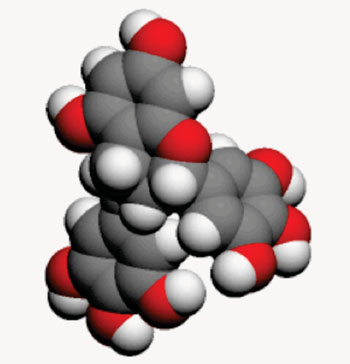Alternative Cancer Treatments May Be Based on Green Tea Components
By LabMedica International staff writers
Posted on 11 Feb 2015
A recent paper suggested that the green tea component epigallocatechin-3-gallate (EGCG) could be developed into an alternative treatment for oral cancer that would not have the severe side effects of current chemotherapeutic agents. Posted on 11 Feb 2015
EGCG is the most abundant catechin in tea and is a potent antioxidant that may have therapeutic applications in the treatment of many disorders. It is found in green tea but not black tea.

Image: Space-filling molecular model of epigallocatechin gallate (EGCG)(Photo courtesy of Wikimedia Commons).
Investigators at Pennsylvania State University (University Park, USA) previously reported that EGCG could induce oxidative stress in oral cancer cells but exerted antioxidant effects in normal cells. Now, in a follow-up study, they treated cultures of human oral squamous carcinoma cells (SCC-25, SCC-9), pre-malignant leukoplakia cells (MSK-Leuk1), and normal human gingival fibroblast cells (HGF-1) with various doses of EGCG.
They reported in the November 17, 2015, online issue of the journal Molecular Nutrition and Food Research that EGCG suppressed sirtuin 3 (silent mating type information regulation 2 homolog 3 or SIRT3) mRNA and protein expression, as well as SIRT3 activity in SCC-25 cells, whereas it increased SIRT3 activity in HGF-1 cells. SIRT3 is the third member of the mammalian sirtuin family, which exhibits NAD+-dependent deacetylase activity.
EGCG selectively decreased the nuclear localization of the estrogen-related receptor alpha (ERRalpha), the transcription factor regulating SIRT3 expression, in SCC-25 cells. This indicated that EGCG might regulate SIRT3 transcription in oral cancer cells via ERRalpha. EGCG also differentially modulated the mRNA expressions of SIRT3-associated downstream targets including glutathione peroxidase 1 and superoxide dismutase 2 in normal and oral cancer cells.
"EGCG plays an important role in mitochondrial function and in anti-oxidant response in lots of tissues in the body, so the idea that EGCG might selectively affect the activity of sirtuin 3 in cancer cells—to turn it off—and in normal cells—to turn it on—is probably applicable in multiple kinds of cancers," said senior author Dr. Joshua D. Lambert, associate professor of food science at Pennsylvania State University. "EGCG is doing something to damage the mitochondria and that mitochondrial damage sets up a cycle causing more damage and it spirals out, until the cell undergoes programmed cell death. It looks like EGCG causes the formation of reactive oxygen species in cancer cells, which damages the mitochondria and the mitochondria responds by making more reactive oxygen species."
"The problem with a lot of chemotherapy drugs - especially early chemotherapy drugs - is that they really just target rapidly dividing cells, so cancer divides rapidly, but so do cells in your hair follicles and cells in your intestines, so you have a lot of side effects," said Dr. Lambert. "But you do not see these sorts of side effects with green tea consumption."
Related Links:
Pennsylvania State University













